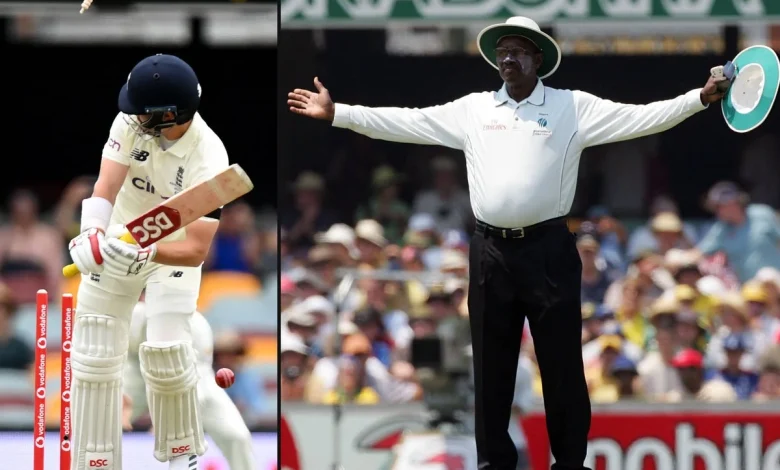England and Australia beware: The first ball of the Ashes can set the tone

The Athletic has launched a Cricket WhatsApp Channel. Click here to join.
It can set the tone for a whole series, the very first ball of the 13,500 that are scheduled to be delivered if this Ashes series goes the full distance.
‘Every ball counts’ is the marketing slogan for the shortest format in cricket, the Hundred, but it is equally applicable in the longest and oldest form of the game, as the history of the Ashes tells you. Perhaps the first ball means most of all.
The first delivery — and certainly the first day — has been heavy in significance in modern Ashes series, meaning all eyes will be on the Optus Stadium in Perth on Friday morning, whoever is bowling, from the moment that opening salvo is fired.
The modern history of immediate drama goes back more than 30 years when, in truth, the opening ball of the 1994-95 series not only set the tone for that Ashes but an era of almost unbroken Australian dominance over the old enemy on home soil.
It was then that the first delivery of the Ashes, bowled at the Australian fortress of the Gabba in Brisbane, broke the hearts of Mike Atherton’s England team and sent Mark Taylor’s Australia on their way to what would become a convincing 3-1 victory.
Phil DeFreitas was not even meant to be bowling the opening over of that series once Taylor had won the toss and took the obvious decision to bat first. That ‘honour’ was meant to go to Devon Malcolm but he was sidelined by chickenpox.
Instead, DeFreitas bowled what was something of a loosener, short and wide outside off-stump, and rather than letting the ball pass peacefully through to the wicketkeeper, as was the wont of most openers of that era, Slater smacked it through cover point for four.
Michael Slater forces off the back foot (Ben Radford/ALLSPORT)
“The scorebook confides that Slater hit the first ball of the series for four,” wrote the great Australian cricket writer Gideon Haigh, then at The Australian, at the time. “It relates nothing of how eyes rolled, shoulders sagged and hearts sank among English players, spectators and journalists.”
England’s suffering did not end there. Slater went on to hit a brilliant 176 out of Australia’s 426, with 25 fours, as the hosts won the first Test by 184 runs.
“Our preparation had gone well until Devon went down ill,” DeFreitas later told the Daily Telegraph. “But I was still looking forward to bowling the first delivery of an Ashes. I had worked out which end I wanted to bowl, I was in the zone and I knew how I wanted to tease Michael Slater with an outswinger.
“But as we walked out at the Gabba before the start, Mike Gatting turned round to our captain Mike Atherton, observed the wind had changed direction and said I should open from the Stanley Street End.
“I had made up my mind to bowl from the Vulture Street End and perhaps I should have stood firm. But I went along with the change and when it came to the first ball, it just didn’t seem right.”
Steve Harmison knows all about the extreme highs and lows of bowling the first ball of an Ashes series. In 2005, he set the tone for one of England’s great triumphs in the first Test at Lord’s when he sent the first ball searing up the slope and past the nose of Justin Langer.
Harmison, at his best one of the fastest and most hostile bowlers England have produced, then struck Langer on the arm with his second delivery and later hit Australian captain Ricky Ponting with such force on the helmet that he drew blood.
“By lunch, our camp looked more like an emergency room than a dressing room,” Langer wrote in his BBC column. “Bodies and egos were bruised and cut to shreds.”
The standard had been very much set and Australia knew England would be a different proposition this time, even though the visitors would go on to win that first Test. England went on to win a fabled series 2-1.
Fast forward to the next Ashes 18 months later, and at Brisbane, the narrative was cast when Harmison, again, bowled the first ball of the series to Langer, again — but this time, the England bowler’s delivery was so wide, it went straight to Andrew Flintoff at second slip.
Steve Harmison’s first delivery in 2006 flies towards Andrew Flintoff at second slip (Hamish Blair/Getty Images)
Never has a first delivery been such a taste of things to come. By the end of the series, England had lost 5-0, Flintoff’s captaincy was in tatters and even the legacy of one of their greatest coaches, Duncan Fletcher, had been tainted.
“I let the enormity of the occasion get to me,” Harmison told reporters afterwards. “My whole body was nervous. I could not get my hands to stop sweating. The first ball slipped out of my hands, the second did as well and, after that, I had no rhythm, nothing.”
Sometimes a series can be influenced or even defined before a ball is bowled.
Nasser Hussain’s decision to bowl first on winning the toss at the start of the 2002-03 Ashes in Brisbane has gone down in Ashes infamy.
It was not just that Australia rattled up the small matter of 364 for two on the first day, but England’s start went from bad to worse when Simon Jones slipped on the outfield and suffered a serious knee injury from which he never fully recovered. England’s Ashes campaign suffered likewise and they lost the first Test by 384 runs and the series 4-1.
England physio Kirk Russell treats a stricken Simon Jones on the outfield in Brisbane (Tom Shaw/Getty Images)
Hussain, now a columnist at The Athletic, is hardly the only captain to have made a wrong call at the toss, both batting or bowling, but he is the one who is always reminded about his faux pas, not least in the Sky TV commentary box whenever the subject comes up.
“I was trying to reinvent the wheel and that decision was made simply because of a scrambled brain,” says Hussain.
“Injuries had hit us hard and I feared we didn’t have a bowling attack that could take 20 wickets against that Australian side in Australia. So I was looking for something in the pitch that wasn’t there and made completely the wrong decision.
“Within an hour, I knew I’d got it wrong. I don’t mind it coming up now on TV. I tell the story against myself, too. It didn’t cost us the series or even that Test. We were just playing against a better side than us and we needed everything to go our way if we were going to compete. And things just didn’t go our way.
“If I do look back with regrets in my captaincy, it is to that one-day final against India at Lord’s (in 2002) when we had them five down cheaply chasing more than 300 and lost.
“I also look at that World Cup game in Port Elizabeth against Australia (in 2003) when Andy Bichel came in to join Michael Bevan and smacked Jimmy Anderson all round the park.
“But not the Brisbane toss because we were up against one of the great Australian sides.”
A bad start has not always meant Ashes disaster for England. Andrew Strauss’ side of 2010-11 went into the first Test at the Gabba on the back of three warm-up games that had seen them win two and draw their other match, all against tough opposition.
But Strauss was caught by Mike Hussey off Ben Hilfenhaus’ third ball of the Test for a duck, Peter Siddle went on to take a first-day hat-trick and England were bowled out for 260.
When Australia replied with 481, another calamitous Ashes series in Australia looked on the cards for England, but they responded with one of their great rearguards, making 517 for one in the second innings to draw. England went on to win the series 3-1.
A dejected Andrew Strauss shuffles off having been dismissed by Ben Hilfenhaus’ third ball of the 2010-11 series (Hamish Blair/Getty Images)
“It was brutal for me,” Strauss tells The Athletic. “I was so keen to set the tone and lead by example. I’d got runs in the warm-up games and I was feeling really confident, so it was the biggest hammer blow to be out third ball. But in those circumstances as a captain, you have to show it doesn’t affect you and it’s just another game of cricket.
“We had to extricate ourselves out of a tough situation on day one and that’s what we were able to do in the end. For the first three days of that first Test, it was, ‘Same old story’ and people were thinking, ‘Here we go again’. Then the way we finished that Test was a huge momentum swing in our favour and something not many people expected.
“The pitch flattened out, there’s no doubt about that, but in terms of setting the tone and making a statement, we showed a lot of resilience and that was hugely important.
“When England teams go to Australia, there is always that fear of the ghosts of tours past coming back to haunt you. Generally, England sides don’t do well in Australia and if things start going off track, you do have that feeling of deja vu. But we were able to arrest that at the back end of that Test.”
The first balls of each of the last two Ashes series were classics of their genre.
In the Covid-19-affected series in Australia in 2021-22 — the one Stuart Broad told the Daily Mail should be declared void — Rory Burns moved so far over his stumps, yet again in Brisbane, he was bowled neck and crop by Mitchell Starc.
It was a miserable series both on and off the field for England, forced to live in various Covid-quarantined bubbles in different states with different rules, and they ended up losing 4-0 to take their miserable run in Australia to 15 Tests without a single victory.
“Did I visualise getting bowled first ball of the Ashes? No, I did not,” Burns told ESPN Cricinfo after being dropped by England in 2022. “But I’ve put it to bed, to be honest.
“It did take a little bit of time, a bit of reflection. You have to take stock of your thoughts as you go along. The Covid bubbles were quite intense and the Ashes bubble was the most intense process we went through.
“But I’ve got a little one at home, I’ve got my wife. They were with me on tour and they helped put it all into context. I reassessed my game after that, made a few tweaks, and went again. It was tough but I rationalised it and got back on the wagon.”
Rory Burns is bowled round his legs by Mitchell Starc’s first ball of the 2021-22 Ashes (Bradley Kanaris/Getty Images)
It was very different for a very different England opener in Zak Crawley in the last Ashes two years ago. ‘Bazball’ had been in business a year, Australia captain Pat Cummins responded with defensive fields — and Crawley still hammered the first ball at Edgbaston from the Australian skipper through the covers for four.
It was the most expansive shot played successfully to a first ball in the Ashes since Slater all those years ago, but it did not lead to an England victory. They lost narrowly in a Birmingham nail-biter by two wickets but drew the series 2-2.
And despite the positive nature of Bazball, Crawley’s opening partner Ben Duckett insists he did not see that shot coming.
First ball of the Ashes. Four runs 🤩
That was some way to kick off a series! 🔥
Relive more iconic Ashes moments like this in our Ashes Hub: https://t.co/VP0Yl1uWew 🙌 pic.twitter.com/qqXvJUoc2k
— England Cricket (@englandcricket) November 5, 2025
“That first ball at Edgbaston summed up where we’re at as a partnership,” Duckett tells The Athletic. “There was no pre-conceived plan. I didn’t know he was going to go and do that. He certainly didn’t tell me.
“Zak is one of those batters who can middle it from ball one, whereas sometimes it will take me five or 10 balls.
“When he’s facing the first ball, it can set the tone really well. He’s obviously such a big presence (at 6ft 4in) and who knows what will happen first ball in Perth? Maybe I’ll ask him before we go out this time.”
Crawley was asked last week about the prospect of facing the first delivery of the series and suggested he would “just watch the ball and play it on its merits”, but did insist that, if it proves to be a half-volley, “I’ll try and drive it — just see the ball and hit the ball.”
Whatever happens, and whoever bats first in Perth, it will be wise not to miss the start of play.





